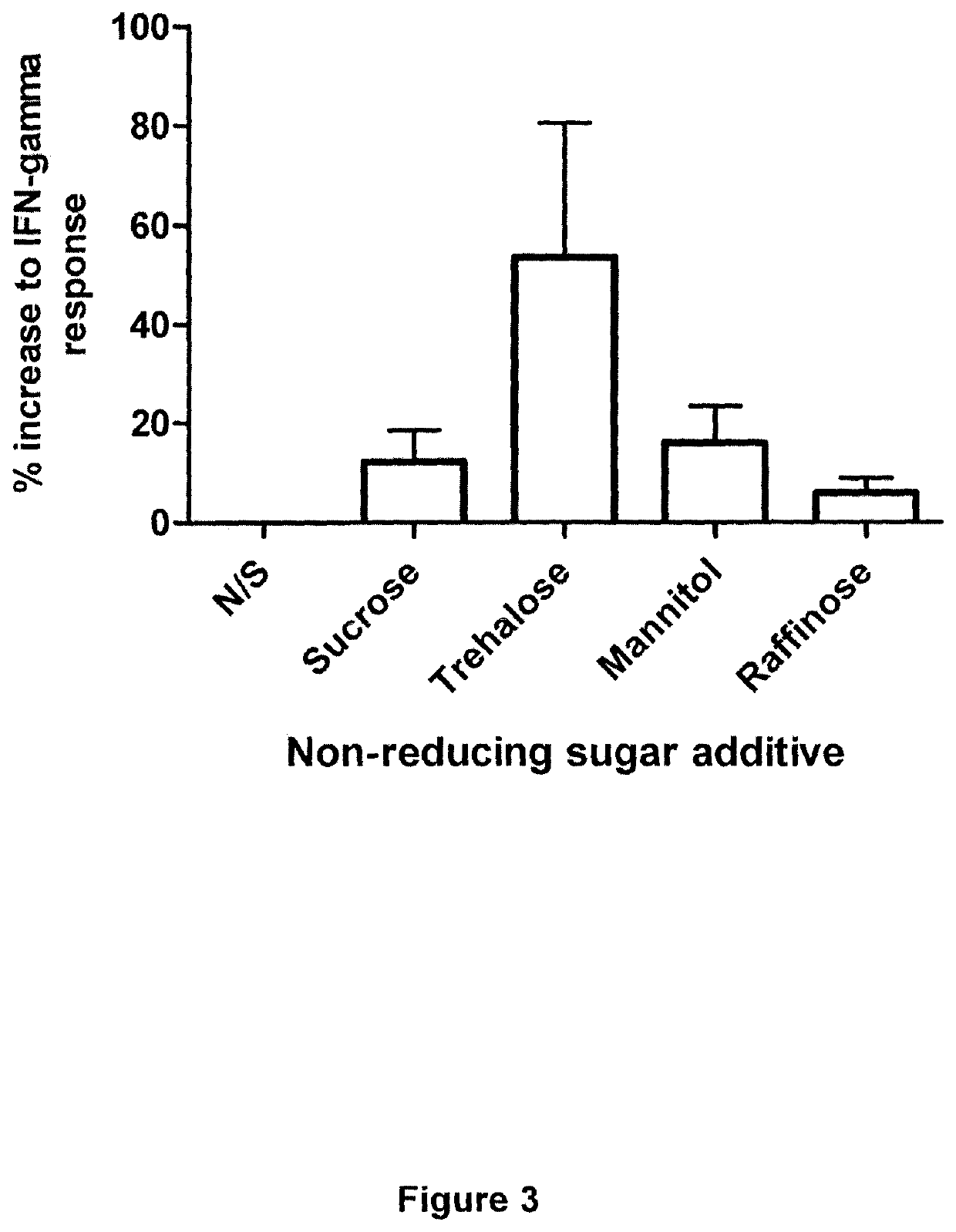Cell mediated immune response assay
a cell-mediated immune response and assay technology, applied in the field of immunological-based assays, can solve the problems of insufficient sensitivity of immunological-based diagnostics, limited shelf life of these kit components, and even complete loss of assay activity, so as to increase the response level and reduce sugars, the effect of increasing sensitivity
- Summary
- Abstract
- Description
- Claims
- Application Information
AI Technical Summary
Benefits of technology
Problems solved by technology
Method used
Image
Examples
specific embodiments
[0063]Specific and preferred embodiments of the method according to the present invention and components used therein will we be described in the following.
[0064]As described above, in step (a), one or more additional additives may be included in the incubation composition. According to one embodiment, an agent is added to the incubation composition to modulate the activity of regulatory T-cells (T-reg cells). The latter encompasses inhibiting the suppressor function of T-reg cells. Agents which modulate T-reg cells encompassed herein include but are not limited to a CD25 ligand, a sense or antisense oligonucleotide to genetic material encoding JAK1 or TYK2, a neutralizing antibody, a CpG containing oligonucleotides, an oligonucleotide acting as a toll-like receptor (TLR) modulating agent, and other TLR modulating agents. In a particular embodiment, the T-reg cells are immune response suppressor cells the activity of which is inhibited by the modulating agent. A “CpG molecule” means...
example 1
f Trehalose on the Sensitivity of the Epstein-Barr Virus Assay
[0180]Investigations using QuantiFERON technology to measure responses to the model antigen EBNA-1 from the Epstein-Barr virus were performed to assess increases in assay sensitivity induced by the addition of non-reducing sugars to the incubation mixture. Briefly, EBNA-1 peptides were added to a blood collection tube, plus / minus 3 concentrations of a trehalose solution (0.5, 1.0 or 2.0 mg / ml trehalose). QuantiFERON assay measuring anti-EBV cellular immune responses was run according to the manufacturer's instructions. The IFN-gamma response was determined and compared depending on the concentration of trehalose. An increase in IFN-gamma response was observed with increasing trehalose concentration. A concentration of 2 mg / ml trehalose provided the best results in this test assay.
[0181]These studies demonstrate that the addition of a non-reducing sugar, such as trehalose, to the whole blood assay results in a significant ...
example 2
tability of a Prior Art Assay
[0182]In this example, a cell-mediated immune response test against CMV was performed and the storage stability of assay components was analysed. As antigen, synthetic peptides, 8-12 amino acids in length, from cytomegalovirus-associated antigens were used. The CMV-associated synthetic peptides were formulated in solution containing a simple sugar (glucose) and sprayed onto the inside of a blood collection tube and dried. Therefore, the antigen and the simple sugar were comprised in one composition. Stability testing of said composition comprised in the blood collection tube indicated that assay activity diminished with time stored at room temperature. Moreover, assay activity of the CMV device was lost when the blood collection device comprising the spray-dried composition comprising the antigen and glucose was stored at 55° C. for a period greater than 3 weeks (21 days). Therefore, respective compositions and accordingly, collection tubes comprising re...
PUM
| Property | Measurement | Unit |
|---|---|---|
| concentration | aaaaa | aaaaa |
| concentration | aaaaa | aaaaa |
| temperatures | aaaaa | aaaaa |
Abstract
Description
Claims
Application Information
 Login to View More
Login to View More - R&D
- Intellectual Property
- Life Sciences
- Materials
- Tech Scout
- Unparalleled Data Quality
- Higher Quality Content
- 60% Fewer Hallucinations
Browse by: Latest US Patents, China's latest patents, Technical Efficacy Thesaurus, Application Domain, Technology Topic, Popular Technical Reports.
© 2025 PatSnap. All rights reserved.Legal|Privacy policy|Modern Slavery Act Transparency Statement|Sitemap|About US| Contact US: help@patsnap.com



